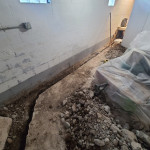Basements are highly susceptible to water intrusion, leading to costly damage and mold growth. Using a mix of waterproofing techniques provides comprehensive protection, creating a safe and dry space. This article explores proven methods for basement waterproofing, highlighting the benefits of each approach.
Interior Waterproofing Methods for Managing Basement Moisture
Interior waterproofing is a practical approach to managing basement moisture and preventing water damage from within the home. These methods are designed to control moisture and redirect water that seeps into the basement, helping to keep the area dry and reduce the risk of mold and structural issues.
1. Perimeter Drains and Floor Channel Systems
Interior drainage systems such as perimeter drains and floor channels effectively direct water away from vulnerable areas within the basement.
Perimeter Drain Systems
Perimeter drains, or interior French drains, are installed around the basement floor edge to capture groundwater that may seep in. This water is then guided to a sump pump for removal. Perimeter drains are especially useful for homes with high water tables, as they allow water to exit before it accumulates.
Floor Channels for Immediate Water Collection
Floor channels are placed along the basement walls, where water often collects. These channels direct water to a sump pump or drainage system, preventing it from pooling on the floor. This solution works well for homes with occasional seepage, as it keeps the basement dry without extensive excavation.
2. Sump Pumps and Backup Systems for Reliable Water Removal
Sump pumps are essential in any waterproofing plan, especially in areas with frequent rain or high groundwater levels.
High-Capacity Primary Sump Pumps
High-capacity sump pumps can quickly handle large volumes of water, making them ideal for homes in flood-prone areas. These pumps operate automatically, are activated by rising water levels in the sump pit, and provide consistent water removal.
Dual and Backup Pump Systems
A dual pump system includes a secondary pump to handle overflow during extreme weather or peak water flow. Backup systems, such as battery-powered or water-pressure-driven pumps, ensure protection during power outages, ensuring your basement stays dry even in emergencies.
3. Sealants and Moisture-Blocking Barriers
Waterproof sealants and vapor barriers help prevent water and moisture from entering through basement walls and floors.
Polyurethane Crack Sealants
Polyurethane sealants fill cracks and minor openings in walls, creating a flexible, water-resistant barrier. Unlike epoxy, which is rigid, polyurethane expands and contracts with foundation shifts, maintaining a tight seal over time.
Polyethylene Vapor Barriers
A polyethylene vapor barrier, applied to walls and floors, prevents moisture from passing through porous concrete surfaces. This barrier also reduces humidity levels in the basement, minimizing the risk of mold and mildew growth. Vapor barriers are particularly useful in humid climates, as they help create a stable, dry environment in the basement.
Exterior Waterproofing Solutions for Stopping Water at the Source
Exterior waterproofing techniques address water outside the home, preventing it from reaching the basement walls and foundation.
1. Membrane Applications for Foundation Walls
Applying waterproof membranes to the foundation walls creates a barrier that keeps water from penetrating.
Bituminous Membranes
Bituminous membranes are commonly used for exterior waterproofing due to their durability and water resistance. These membranes are applied as a thick coating or in sheet form, covering the foundation walls entirely. They are effective in wet climates, where heavy soil moisture can lead to constant water pressure against the basement.
Liquid Rubber Coatings
Liquid rubber coatings are another excellent option for waterproofing foundation walls. They’re applied by spray or roller and dry to form a flexible, seamless layer that keeps water out. Liquid coatings are easy to apply, making them a popular choice for homeowners seeking DIY solutions for exterior waterproofing.
2. French Drains and Footing Drains for Groundwater Control
Exterior drainage systems manage groundwater around the foundation, channeling it away to reduce hydrostatic pressure.
French Drains
Exterior French drains are installed at the base of the foundation and use a perforated pipe within a gravel-filled trench to capture water and redirect it to a drainage outlet. A filter fabric around the pipe keeps debris out, preventing clogs and ensuring smooth water flow.
Footing Drains
Footing drains are installed directly at the foundation’s base, capturing water before it rises and pushes against basement walls. By relieving pressure, footing drains reduce the likelihood of foundation cracks and leaks. Regular maintenance of footing drains ensures they remain effective, particularly in high-moisture areas.
3. Landscaping Adjustments and Surface Water Control
Landscape adjustments can improve drainage around the home, reducing the amount of water that reaches the foundation.
Grading and Soil Slope Adjustments
Proper grading is essential to ensure that rainwater flows away from the foundation. Creating a slope 5-10% away from the home can prevent water pooling near basement walls, reducing the risk of seepage.
Water-Tolerant Vegetation and Rain Gardens
Planting water-absorbing plants around the foundation helps control surface water naturally. Native vegetation with deep roots absorbs water efficiently, while rain gardens create a controlled space for runoff, preventing it from reaching the foundation.
Combining both interior and exterior basement waterproofing methods offers a comprehensive defense against water intrusion. With the use of drainage systems, sump pumps, sealants, and proper landscaping, homeowners can protect their basements from moisture, preserving structural integrity and creating a safe, dry space.
Contact the Professionals at Budget Dry Waterproofing Today! 203-421-8560







